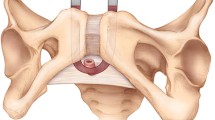Abstract
Introduction
The International Urogynecological Association (IUGA) and the International Continence Society (ICS) developed a complication classification to facilitate international comparison and to improve our understanding of complications. This code was applied to surgical cases for the analysis of complications after mesh insertion.
Methods
The study included patients who had undergone vaginal prolapse repair with a trocar-guided polypropylene mesh between 2006 and 2010 in a Dutch peripheral hospital. Complications were assessed at secondary follow-up and classified using category (C), timing (T), and site (S) components (CTS).
Results
Of the 107 women included, 84 returned for secondary follow-up (response rate 80 %, median time after surgery 36 months, range 12–64). In 45 patients no complications occurred. In the remaining 39 patients, 43 complication codes were established. Six of the seven categories of complications were found at all different time codes. Concerning the site of the complication codes S1, S2, and S3 were applicable. Perioperative complications (6 %) included hemorrhage and bladder perforation. Six patients were reoperated for symptomatic mesh exposure or local pain. At secondary follow-up exposure was diagnosed in another 4 patients (12 %). In 36 % mesh wrinkling or shrinkage was discovered, although without complaints in most. Eight women had daily complaints or dyspareunia. Eighty-two percent of patients indicated strong improvement after surgery. Several limitations of the classification are discussed.
Conclusions
Despite limitations, the IUGA/ICS code is demonstrated to be useful in describing mesh complications. We advise the use of the CTS code at follow-up consultations after a minimum of 2 years for improved insight into and knowledge on the occurrence of complications.
Similar content being viewed by others
References
Slieker-ten Hove MC, Pool-Goudzwaard AL, Eijkemans MJ, Steegers-Theunissen RP, Burger CW, Vierhout ME (2009) Symptomatic pelvic organ prolapse and possible risk factors in a general population. Am J Obstet Gynecol 200:184–187. doi:10.1016/j.ajog.2008.08.070
Luber KM, Boero S, Choe JY (2001) The demographics of pelvic floor disorders: current observations and future projections. Am J Obstet Gynecol 184:1496–1501, discussion 1501–1503
Food and Drug Administration (2011) FDA Safety Communication: update on serious complications associated with transvaginal placement of surgical mesh for pelvic organ prolapse. U.S. Department of Health and Human Services.http://www.fda.gov/MedicalDevices/Safety/AlertandNotices/umc262435.htm. Accessed 30 April 2013
Haylen BT, Freeman RM, Swift SE, Cosson M, Davila GW et al (2011) An International Urogynecological Association (IUGA)/International Continence Society (ICS) joint terminology and classification of the complications related directly to the insertion of prostheses (meshes, implants, tapes) and grafts in female pelvic floor surgery. Int Urogynecol J 22:3–15. doi:10.1007/s00192-010-1324-9
Firoozi F, Ingber MS, Moore CK, Vasavada SP, Rackley RR, Goldman HB (2012) Purely transvaginal/perineal management of complications from commercial prolapse kits using a new prostheses/grafts complication classification system. J Urol 187:1674–1679. doi:10.1016/j.juro.2011.12.066
Skala C, Renezeder K, Albrich S, Puhl A, Laterza RM, Naumann G, Koelbl H (2011) The IUGA/ICS classification of complications of prosthesis and graft insertion: a comparative experience in incontinence and prolapse surgery. Int Urogynecol J 22:1429–1435. doi:10.1007/s00192-011-1508-y
Petri E, Ashok K (2012) Complications of synthetic slings used in female stress urinary incontinence and applicability of the new IUGA-ICS classification. Eur J Obstet Gynecol Reprod Biol 165:347–351. doi:10.1016/j.ejogrb.2012.08.011
Bump RC, Mattiasson A, Bø K, Brubaker LP, DeLancey JO, Klarskov P, Shull BL, Smith AR (1996) The standardization of terminology of female pelvic organ prolapse and pelvic floor dysfunction. Am J Obstet Gynecol 175:10–17
Fatton B, Amblard J, Debodinance P, Cosson M, Jacquetin B (2007) Transvaginal repair of genital prolapse: preliminary results of a new tension-free vaginal mesh (prolift technique) - a case series multicentric study. Int Urogynecol J Pelvic Floor Dysfunct 18:743–752
Van der Vaart CH, de Leeuw JR, Roovers JP, Heintz AP (2003) Measuring health-related quality of life in women with urogenital dysfunction: the urogenital distress inventory and incontinence impact questionnaire revisited. Neurourol Urodyn 22:97–104
Van Brummen HJ, Bruinse HW, van de Pol G, Heintz AP, van der Vaart CH (2006) Defecatory symptoms during and after the first pregnancy: prevalences and associated factors. Int Urogynecol J Pelvic Floor Dysfunct 17:224–230
Rogers RG, Coates KW, Kammerer-Doak D, Khalsa S, Qualls C (2003) A short form of the pelvic organ prolapse/urinary incontinence sexual questionnaire (PISQ-12). Int Urogynecol J Pelvic Floor Dysfunct 14:164–168, discussion 168
Srikrishna S, Robinson R, Cardozo L (2010) Validation of the patient global impression of improvement (PGI-I) for urogenital prolapse. Int Urogynecol J 21:523–528. doi:10.1007/s00192-009-1069-5
Gutman RE, Nygaard IE, Ye W, Rahn DD, Barber MD, Zyczynski HM et al (2013) The pelvic floor complication scale: a new instrument for reconstructive pelvic surgery. Am J Obstet Gynecol 208:81–89. doi:10.1016/j.ajog.2012.10.889
Gowda M, Kit LC, Stuart Reynolds W, Wang L, Dmochowski RR, Kaufman MR (2013) Interobserver variability when employing the IUGA/ICS classification system for complications related to prostheses and grafts in female pelvic floor surgery. Int Urogynecol J 24:1671–1678. doi:10.1007/s00192-013-2078-y
Tunitsky E, Abbott S, Barber MD (2012) Interrater reliability of the International Continence Society and International Urogynecological Association (ICS/IUGA) classification system for mesh-related complications. Am J Obstet Gynecol 206:442–426. doi:10.1016/j.ajog.2012.03.004
Withagen MI, Milani AL (2007) Which factors influenced the result of a tension free vaginal tape operation in a single teaching hospital? Acta Obstet Gynecol Scand 86:1136–1139
Ennemoser S, Schönfeld M, von Bodungen V, Dian D, Friese K, Jundt K (2012) Clinical relevance of occult stress urinary incontinence (OSUI) following vaginal prolapse surgery: long-term follow-up. Int Urogynecol J 23:851–855. doi:10.1007/s00192-012-1765-4
Acknowledgements
We would like to thank M. Scheltes for her assistance with the database.
Conflicts of interest
None.
Financial disclaimer
None.
Author information
Authors and Affiliations
Corresponding author
Rights and permissions
About this article
Cite this article
Bontje, H.F., van de Pol, G., van der Zaag-Loonen, H.J. et al. Follow-up of mesh complications using the IUGA/ICS category–time–site coding classification. Int Urogynecol J 25, 817–822 (2014). https://doi.org/10.1007/s00192-013-2321-6
Received:
Accepted:
Published:
Issue Date:
DOI: https://doi.org/10.1007/s00192-013-2321-6




